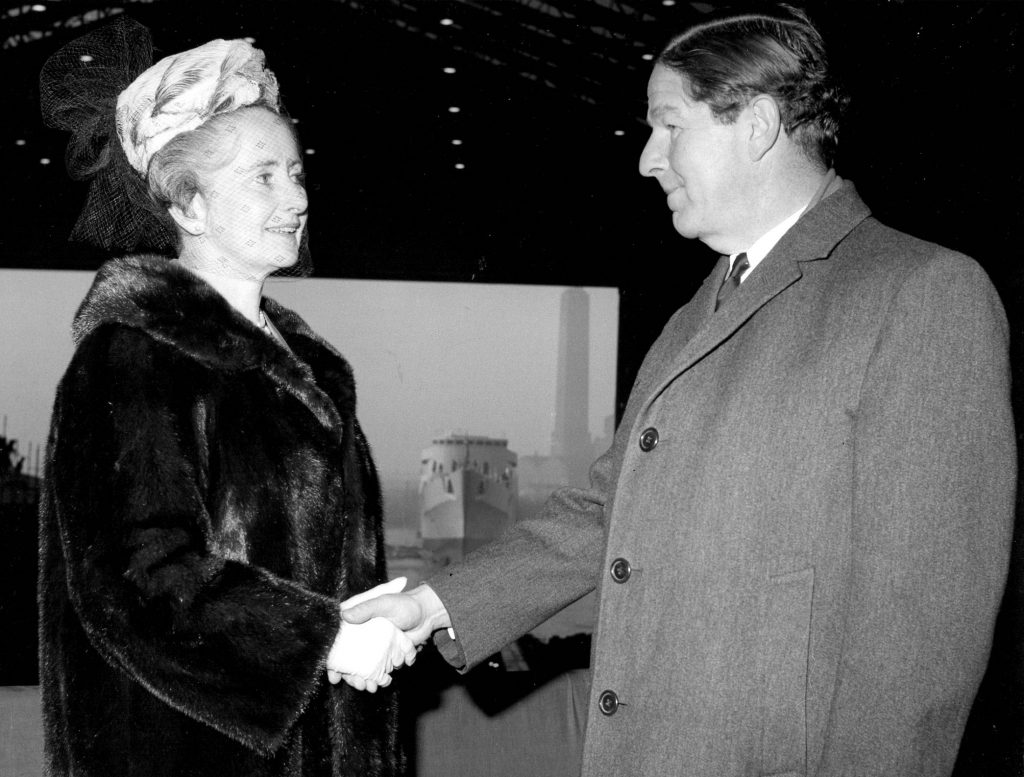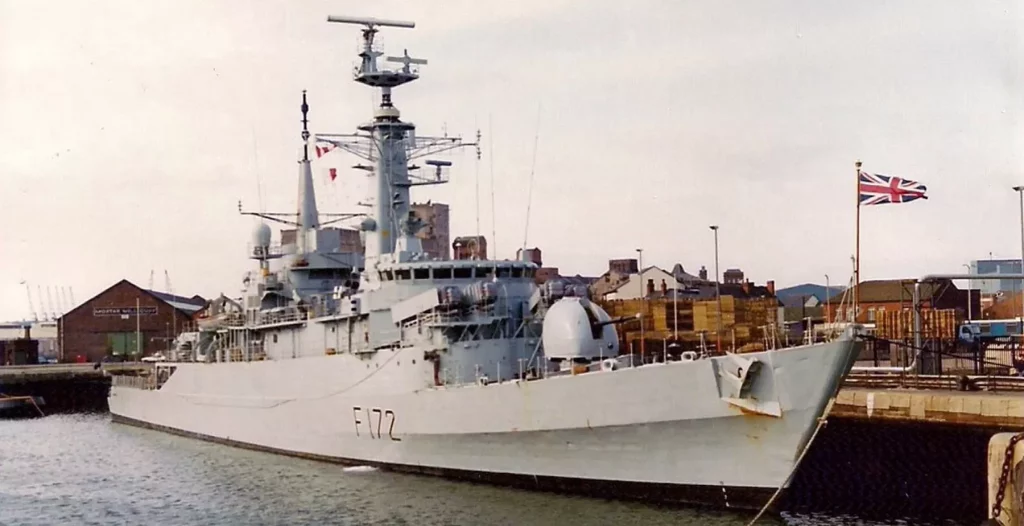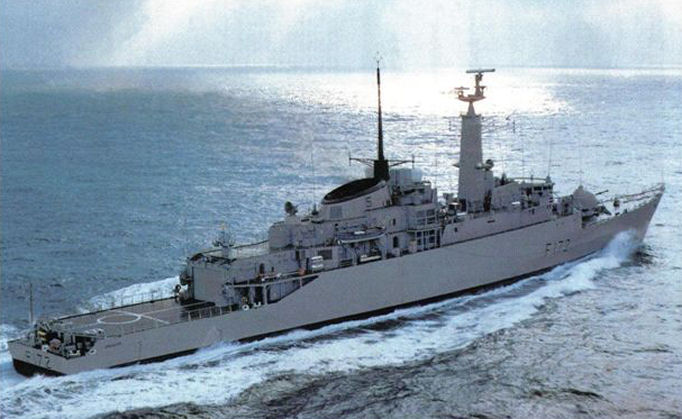The River Clyde’s shipbuilding history is one of the most significant and influential in the world, with a heritage that spans centuries. HMS Ambuscade forms part of this rich history bringing together the craftsmanship of Clyde shipbuilding, and the Navies of two nations, the United Kingdom and Pakistan.
The Type 21, Amazon class frigate was designed by Vosper Thornycroft, Portsmouth, England in the late 1960’s, for the first time since World War II, the ships were designed by a private contractor rather than MOD designers. They were also the first Royal Navy ships to be powered solely by gas-turbine.
The distinctive sleek, yacht like design and excellent turn of speed, were a trademark of the Type 21’s and they were often referred to as the ‘greyhounds’ or ‘Porsches’ of the Royal Navy. Their primary use was as an anti-submarine and anti-aircraft warfare vessel.
Vosper Thornycroft shipyard built the first three ships the subsequent five were built by Yarrows Shipbuilders Ltd, Scotstoun, Glasgow, Scotland.
Ship Name | Designation | Construction Shipyard |
| HMS Amazon | F169 | Vosper Thornycroft |
| HMS Antelope | F170 | Vosper Thornycroft |
| HMS Active | F171 | Vosper Thornycroft |
| HMS Ambuscade | F172 | Yarrow’s |
| HMS Arrow | F173 | Yarrow’s |
| HMS Alacrity | F174 | Yarrow’s |
| HMS Ardent | F184 | Yarrow’s |
| HMS Avenger | F185 | Yarrow’s |
HMS Ambuscade was the fourth Type 21 to be built but was the first of it’s type to be built on the Clyde at Yarrow’s. HMS Ambuscade was laid down on 1 September 1971.
HMS Ambuscade was launched on 18 January 1973 by Lady Rosemary Griffin wife of the Controller of the Navy, Admiral Sir Anthony Griffin.

The prompt card used by Lady Griffin at launch.
A unique copy of the launch day programme is below.
The extensive guest list of 221 for luncheon included Sir Eric Yarrow and Lady Yarrow, Adm. Sir Anthony Griffin K.C.B. and Lady Rosemary Griffin, Sir Michael Cary K.C.B. , Sir Phillip Southwell and Rear Adm. PA Watson M.V.O.
Guests dined on a starter of Smoked Salmon followed by Roast Duckling with olives, Peas Flamande and Berny Potatoes. Dessert of Chocolate Gateaux, Pears and Cream followed by Petits Fours and Coffee.

Tribute to Lady Rosemary Griffen
HMS AMBUSCADE was launched by Lady Rosemary Griffin on 18 January 1973 at Yarrow (Shipbuilders) Ltd. She was accompanied by her husband, Admiral Sir Anthony Griffin, who at the time was Third Sea Lord and Controller of the Navy. She thus became the ship’s “Sponsor”, a duty which she took very seriously, and which gave her great satisfaction.
Lady Griffin came from a family with many associations with the Royal Navy. Her mother married first a naval officer in World War 1 and was widowed six months later. She then married another naval officer, and they had two children, Rosemary and her younger brother William. During World War 2 Rosemary served in the WRNS based in Plymouth. Her brother died aged 18 in the battleship HMS BARHAM when she was torpedoed in November 1941. Her father served at sea in both world wars and retired as a Vice Admiral. Her son William was also in the RN and joined HMS AMBUSCADE at Yarrows for her first commission.
Lady Griffin always took a close interest in “her ship”. She attended several commissioning ceremonies, including one on her birthday (the band played suitable music). She was also principal guest at the Handover Ceremony at Plymouth on 28 July 1993, when HMS AMBUSCADE became PNS TARIQ. Successive commanding officers were well-advised to keep her regularly updated on the ship’s activities.
Lady Griffin died in February 2015 aged 94.
A special thank you to Bill Griffin for kindly donating the use of the launch day photographs.
HMS Ambuscade was launched on the 18th January 1973 and served in the Royal Navy for over 18 years before being decommissioned and sold to Pakistan in 1993. She is the last remaining Type 21 Frigate and as such, it is crucial that this heritage is preserved, celebrated, and studied to provide insight into the past and inspire future generations of innovators and designers.
At build the ship was equipped with advanced sonar systems and anti-aircraft missile systems, making it a formidable vessel in naval warfare, these consisted of:
One Vickers 4.5in Mk 8 automatic gun
A quadruple launcher for the short Seacat (GWS-24) anti-aircraft missiles
A Westland WG-13 helicopter armed with air to surface guided missiles and anti submarine torpedoes
Two sets of shipborne triple torpedo tubes
2in Rocket Flare launchers(RFL)
Multiple 3in chaff rocket launchers
There were enhancements later which included :
Exocet surface to surface missiles (4)
Secondary guns- 20mm Oerlikon doubled to four.
The Westland Wasp helicopter was later replaced by the Westland Lynx. it’s armaments included:
MK44or Stingray anti submarine torpedoes (2)
Depth charges (2)
Sea Skua anti ship missiles (4)
Sensors
The main surveillance radar was an Echo/Foxtrot band radar used for surface to air warning as well as target indication. It was able to pick up aircraft approximately 70 miles from the ship. Surface contacts were only obtained to horizon level, approximately 20 miles.
The system used for navigation and helicopter control was the Kelvin Hughes 1006 situated halfway up the foremast.
Type 912: I band – gunnery and Seacat trackers
Sonar
The ship was equipped with Type 184 sonar for hunting submarines. Additionally Type 162 , short range, bottom search sonar was also used.
Engines
Rolls Royce Olympus gas turbines (2)
Rolls Royce RM1A Tyne gas turbines (2)
The ship was involved in a range of operations, including anti-submarine and anti-aircraft warfare exercises. During 1976 she undertook sea trials moving onto patrols and general exercises until just after 1976.
As part of her NATO duties HMS Ambuscade joined the Standing Naval Force Atlantic (STANAVFOR-LANT )in March 1977, exercises of this nature varied in length and complexity and could involve a large number of warships from numerous nations and merchant vessels. During this type of exercise it would be normal for the Type 21’s to escort merchant vessels, act as a replenishment ship for others and deploy troops ashore as part of the exercise.
After a spell in dock in 1977 she was deployed to the Western Atlantic and Pacific in 1978.
During 1979 to early 1980 the ship patrolled UK waters, had a 10 month refit in 1980 and served Guardship duties in Belize and the West Indies (these deployments could last up to five months at a time).
After a period of sea training during 1981 the ship was deployed to the Persian Gulf as part of the Armilla Patrol in late 1981. The Armilla Patrol was set up to protect British shipping in the area following the breakout of the Iran/Iraq war.
HMS Ambuscade was part of the UK fleet which took part in the Falklands Conflict in 1982. Her two sister ships, Alacrity and Antelope left Devonport to meet the Royal Fleet Auxiliary on 5th April 1982, HMS Ambuscade left on the 9th of April heading to Gibraltar with munitions to replenish those used by the Task Force as they left for the Falklands. After a three week period of guardship duties HMS Ambuscade returned home to patrol UK waters.
It wasn’t long before she was called upon to serve in the Falklands Conflict where she served as a vital escort vessel for the British fleet. The ship provided critical protection ensuring that the vital supply lines to the Falkland Islands were maintained.
On the 25th of May HMS Ambuscade detected an aircraft some 30ml from the ship. At 22ml it detected the firing of two Exocet missiles from an Argentinian Super Etendard strike aircraft, the ship deployed chaff decoys in an attempt to deflect/confuse the missiles. Both missiles then locked onto the SS Atlantic Conveyor striking her on her port quarter, setting her alight. The Atlantic Conveyor sank whilst she was under tow on 28 May.
On the 13th/ 14th June HMS Ambuscade fired 228 4.5 in shells in support of 2nd Battalion’s assault on Wireless Ridge, five miles from Port Stanley. This area was of strategic importance and needed to be taken in order that British forces could approach the capital which was under Argentinian command. The joint forces attack was successful and the entire Argentine military surrendered later that day.
On her return from the Falklands HMS Ambuscade continued in her Guardship role returning to the Armilla Patrol in 1983, West Indies and the Falklands on numerous occasions up until she was sold to the Pakistan Navy in 1993.

The ship’s contributions to the Royal Navy during her time in service were significant and helped to maintain the UK’s naval dominance on the world stage.
After being decommissioned by the Royal Navy, HMS Ambuscade was sold to Pakistan and was renamed PNS Tariq. The ship served in the Pakistan Navy for nearly three decades, from 1993 to 2023.
HMS Ambuscade / PNS Tariq, is set to become the UK’s first Cold War Museum ship, and it is hoped that she may also become an official Falklands Conflict memorial warship exhibit once she is returned to Glasgow. The significance of this ship lies in its historical value, having served during the Cold War and Falklands War. The vessel’s preservation as a museum ship will offer a unique insight into the operations and technology of naval warfare during these significant periods in history. The vessel will allow visitors to step back in time and experience first hand what life was like on a naval vessel during these conflicts.
By becoming the UK’s first dual nationality, Cold War Museum ship and an official Falklands Conflict memorial warship exhibit, HMS Ambuscade will serve as a living tribute to the men who served on board her. The preservation of the vessel as a museum ship will also act as a reminder of the vital role that the Royal Navy played in defending the nation’s interests and upholding global peace during the Cold War and Falklands Conflict.



| Rank & Name | From | To | |
| Cdr Anthony Harris | Aug 75- | Oct-76 | |
| Cdr Peter Abbott | Oct-76 | Nov-77 | |
| Cdr Michael Gretton | Nov-77 | Feb-80 | |
| Cdr Bryan Burns | Feb-80 | Jan-82 | |
| Cdr Peter Mosse | Jan-82 | Sep-83 | |
| Cdr Anthony Bolingbroke | Sep-83 | Nov-84 | |
| Cdr John Harvey | Oct-85 | Jul-87 | |
| Cdr Stephen Mackay | Jul-87 | Nov-88 | |
| Cdr Michael James | Nov-88 | Jun-90 | |
| Cdr Michael Knowles | Jun-90 | Dec-91 | |
| Cdr Stephen Kirby | Dec-91 | May-93 |
| Ship | Town |
| HMS Active | Burnley, Lancs |
| HMS Alacrity | Winchester |
| HMS Amazon | Southampton |
| HMS Ambuscade | Crewe |
| HMS Antelope | Hereford |
| HMS Ardent | Haverford West |
| HMS Arrow | Sunderland |
| HMS Avenger | Fowey |
Our mission at Clyde Naval Heritage is to preserve and celebrate the rich heritage of the River Clyde’s shipbuilding industry, highlighting the contributions of the industry to the development of both Merchant and Royal Navy ships. Through education and collaboration, we aim to inspire future generations to continue the legacy of innovation and excellence.
Our vision at Clyde Naval Heritage is to create a dynamic and interactive space that celebrates the rich history of the River Clyde’s shipbuilding industry, preserving and showcasing the vessels built for both the Merchant and Royal Navy. We aim to inspire visitors and celebrate the region’s unique maritime legacy.

Copyright © 2024 Clyde Naval Heritage Charity No: SC052802